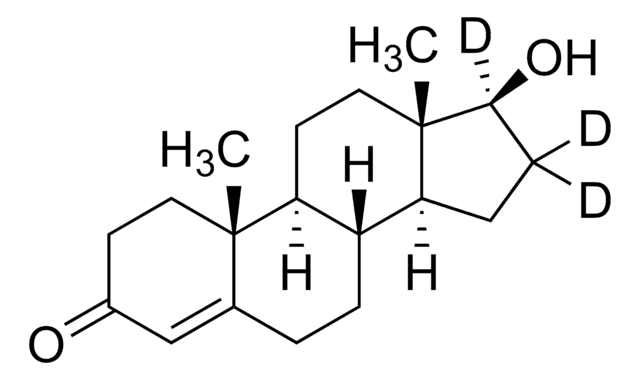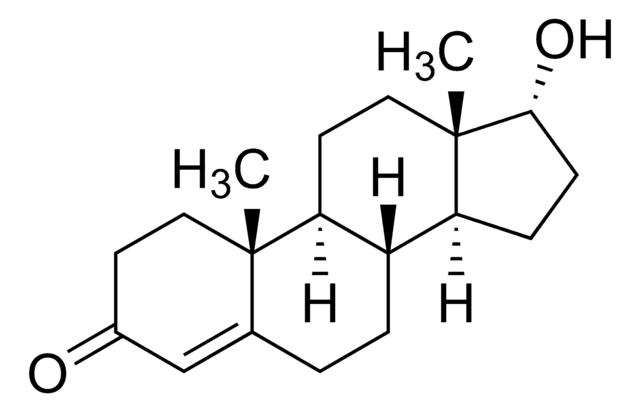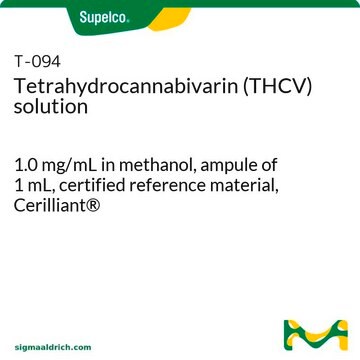Wichtige Dokumente
T4764
Δ9-Tetrahydrocannabinol -Lösung
1.0 mg/mL in methanol, analytical standard, for drug analysis
Synonym(e):
Δ1-Tetrahydrocannabinol
About This Item
Empfohlene Produkte
Qualität
analytical standard, for drug analysis
Qualitätsniveau
drug control
Home Office Schedule 2; stupéfiant (France); kontrollierte Droge in Deutschland; (Spain); Decreto Lei 15/93: Tabela IIB (Portugal)
Konzentration
1.0 mg/mL in methanol
Methode(n)
HPLC: suitable
gas chromatography (GC): suitable
Anwendung(en)
pharmaceutical (small molecule)
Format
single component solution
Lagertemp.
2-8°C
SMILES String
[H][C@@]12CCC(C)=C[C@@]1([H])c3c(O)cc(CCCCC)cc3OC2(C)C
InChI
1S/C21H30O2/c1-5-6-7-8-15-12-18(22)20-16-11-14(2)9-10-17(16)21(3,4)23-19(20)13-15/h11-13,16-17,22H,5-10H2,1-4H3/t16-,17-/m1/s1
InChIKey
CYQFCXCEBYINGO-IAGOWNOFSA-N
Angaben zum Gen
human ... CNR1(1268) , CNR2(1269)
mouse ... Cnr1(12801)
rat ... Cnr1(25248)
Suchen Sie nach ähnlichen Produkten? Aufrufen Leitfaden zum Produktvergleich
Allgemeine Beschreibung
Anwendung
- Development and validation of a high-performance liquid chromatographic method coupled with UV detection to measure cannabidiol and ∆9-tetrahydrocannabinol in rat plasma samples following their extraction by protein precipitation and liquid-liquid extraction (LLE)
- Estimation of cannabidiol and ∆9-tetrahydrocannabinol extracted from human plasma samples by liquid-liquid extraction using ultra-performance liquid chromatography with triple quadrupole mass spectrometry
- Multi-residue analysis of Δ9-tetrahydrocannabinol (THC) and its two degradation products, 11-hydroxy-Δ9-tetrahydrocannabinol and 11-nor-9-carboxy-Δ9-tetrahydrocannabinol, in whole blood samples by QuEChERS extraction and gas chromatography (GC) coupled with tandem mass spectrometry (MS/MS)
- Optimization of an ultra-high performance supercritical fluid chromatographic (UHPSFC) method, combined with a tandem mass spectrometer (MS/MS) to determine ∆9-tetrahydrocannabinol, along with three of its major metabolites and four synthetic metabolites in wastewater samples following liquid-liquid extraction
- Development and validation of an ultra high-performance liquid chromatographic (UHPLC) method coupled to photodiode array and mass spectrometry detectors to determine 11 cannabinoids in various Cannabis Sativa samples
Sonstige Hinweise
Signalwort
Danger
H-Sätze
Gefahreneinstufungen
Acute Tox. 3 Dermal - Acute Tox. 3 Inhalation - Acute Tox. 3 Oral - Flam. Liq. 2 - STOT SE 1
Zielorgane
Eyes,Central nervous system
Lagerklassenschlüssel
3 - Flammable liquids
WGK
WGK 2
Flammpunkt (°F)
49.5 °F - closed cup
Flammpunkt (°C)
9.7 °C - closed cup
Persönliche Schutzausrüstung
Eyeshields, Faceshields, Gloves, type ABEK (EN14387) respirator filter
Zulassungslistungen
Zulassungslistungen werden hauptsächlich für chemische Produkte erstellt. Für nicht-chemische Produkte können hier nur begrenzte Angaben gemacht werden. Kein Eintrag bedeutet, dass keine der Komponenten gelistet ist. Es liegt in der Verantwortung des Benutzers, die sichere und legale Verwendung des Produkts zu gewährleisten.
EU REACH Annex XVII (Restriction List)
Hier finden Sie alle aktuellen Versionen:
Besitzen Sie dieses Produkt bereits?
In der Dokumentenbibliothek finden Sie die Dokumentation zu den Produkten, die Sie kürzlich erworben haben.
Kunden haben sich ebenfalls angesehen
Artikel
Tetrahydrocannabinolic acid A solution, 1.0 mg/mL in acetonitrile, ampule of 1 mL, certified reference material.
Unser Team von Wissenschaftlern verfügt über Erfahrung in allen Forschungsbereichen einschließlich Life Science, Materialwissenschaften, chemischer Synthese, Chromatographie, Analytik und vielen mehr..
Setzen Sie sich mit dem technischen Dienst in Verbindung.













